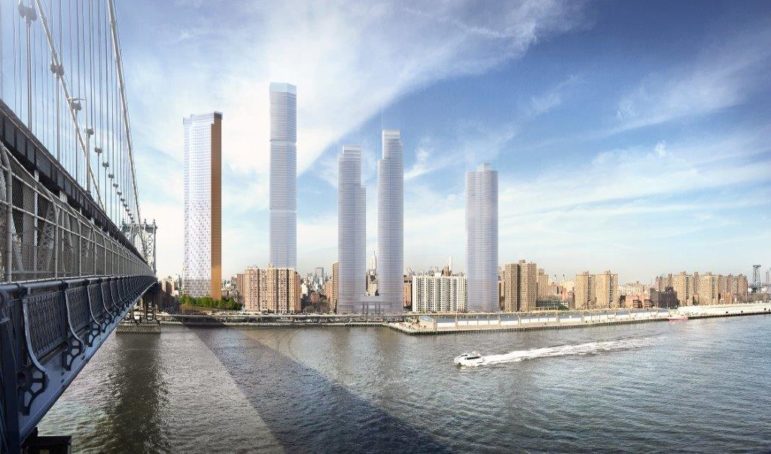
Risa Heller Communications
A rendering of the proposed projects.
The controversial plan for new skyscrapers in Two Bridges passed the City Planning Commission vote Wednesday despite protests against the size of the developments and the application process from residents and elected officials.
Out of the 13-member commission, members Michelle de la Uz, Anna Levin and Raj Rampershad voted against the joint application for a minor modification in the Two Bridges Large Scale Residential Development (LSRD) district. CPC Chair Marisa Lago said before her vote in favor of the application that legally the minor modification meets the conditions of the current zoning regulations, and added that applicants with city agencies have made efforts to invest in the surrounding Two Bridges community.
The de Blasio administration has said the developments do not need to go through the city’s full Uniform Land Use Review Procedure. Lago defended that stance.
“For a straightforward legal matter matter the commission can’t require a ULURP unless authorized to do so by the City Charter and zoning resolution,” she said. “And neither the Charter or zoning resolution authorize a ULURP here.”
Lago said that although a ULURP cannot be authorized for the Two Bridges application it did require an updated floor plan because of the scale of the developments which in turn triggered an environmental impact study and four community outreach sessions.
That process allowed DCP to extract some benefits, such as two elevators at the East Broadway subway station for seniors and those with disabilities, the creation of more than an acre of open space and improvements to existing open spaces and access to alternative transportation such as the ferry service and bicycle path, Lago said.
She said the concerns about construction and traffic would be addressed by creating a community construction task force to address daily needs of the community.
Additionally, the developers have committed to $12.5 million towards the Two Bridges NYCHA campuses for brick, window and systems repairs, said Lago.
Despite those benefits, Commissioner Allen Cappelli, a former Manhattan Community Board 3 member, only hesitantly voted yes, “I nonetheless feel somewhat ambivalent. Part of my reluctance on this issue has been perhaps the frustration with the limitations of an authority over the situation. Essentially our hands are tied, legally,” he said.
But the three commission members who voted against the Two Bridges application said the legality of the zoning resolution was questionable and the benefits did not outweigh the impact the large-scale developments would have on the Two Bridges community.
“While I appreciate the steps the applicants took to joint environmental impact statement and recent commitment to NYCHA, I do not believe the actions the commission is being asked to take today with the LSRD are appropriate nor are they conforming to the original CPC resolution from 1972,” said Commission member Michelle de la Uz.
De la Uz said that the resolution states any alterations in the premises that do not meet the specified conditions, unless authorized by CPC, shall be cause immediate termination. “We are being asked to approve a minor modification that will result in thousands of residential units changes in open space and site plan [as well as] multiple significant environmental impacts. I do not understand how we can vote on such a thing.”
“This case will ultimately be decided by a judge,” she continued. “What is most disturbing to me is the failure of the city to fully acknowledge the extent of the actions and authorizations being sought. The public trust in the government is at all time low and it’s actions such as these that further erode it.”
Levin agreed with de la Uz before her vote against the application and added, “I don’t believe the legal situation is as straightforward as our Chair would have it be. I am not persuaded that the planning principles that were reflected in the large scale plan in the 1972 special permit were extinguished with the expiration of the Urban Renewal plan or that these plans be appropriately approved as minor modifications.”
The last no vote came from newcomer to the City Planning Commission Raj Rampershad, who said he spent over a week reviewing the public sessions and reading the 800-page environmental impact study but still had many questions about construction and concerns about the community. “With that being said, I have a lot more questions than answers, I am going to vote no,” he said.
Two Bridges used to be an Urban Renewal Area, where the city sought to remove blight and create mixed-income housing and employment opportunities. In 1972, the area was designated as a Large-Scale Residential Development (LSRD) area, a district in which the city allows flexibility from normal land-use regulations in order to facilitate the most space-efficient and beneficial site plans for large apartment buildings that span multiple property lots.
A significant element of the controversy over the Two Bridges proposals is that the de Blasio administration has determined they represent only a “minor modification,” and therefore do no require a full Uniform Land Use Review Procedure, or ULURP.
The joint application for a minor modification filed by four developers would allow three new mixed-use high-rise buildings, a 1,008-foot rental tower at 247 Cherry Street by JDS Development Group; a 798-foot dual-tower project at 260 South Street by L+M Development Partners and CIM Group; and a 730-foot building at 259 Clinton Street by Starrett Corporation. According to the DEIS the four towers would bring in 11,000 square feet for retail and over 2,700 new residential units to the area; 25 percent of those units will be affordable. Two hundred of those 690 affordable units would be set aside for seniors (although details of how affordability will be measured has not been shared).
“We appreciate the consideration of the City Planning Commission and feedback from the community on numerous occasions over the past two years. The three proposed projects will deliver lasting and meaningful benefits for the Two Bridges community, including approximately 700 units of permanently affordable housing, funding for essential repairs to the local NYCHA complex, resiliency upgrades for both existing and proposed buildings, an estimated $40 million in upgrades to the East Broadway subway station that will make the station ADA-accessible for the first time, an estimated $15 million in upgrades to three local public parks, and the creation of new public spaces within the LSRD. We look forward to moving ahead with these projects and neighborhood benefits,” said the developers in a joint statement.
Residents and community organizations such as Lower East Side Organized Neighbors (LESON) and Chinatown Working Group did not want any development to take place and plan on taking the city to court. LESON held a protest Tuesday afternoon on 265 Cherry Street,
“Not only do these towers have a mass environmental damage but they will also cause mass displacement if they are built,” said David Tieu, LESON and Chinatown Working Group member. “We have been clear from day one. If the CPC votes yes on these towers and approves these towers, we intend to sue the city.”
Some community organizations such as GOLES, CAAAV along with residents and elected officials had originally hoped that the city would put a hold on the Two Bridges application until a text amendment introduced to the City Council by Councilwoman Margaret Chin and Manhattan Borough President Gale Brewer — which would force the Two Bridges application into a special permit and activate the ULURP process — moved forward in the City Council. The text amendment never gained any traction.
GOLES and CAAAV along with TUFF-LES will join in a lawsuit against the Two Bridges development. A GOLES spokesperson said that community organizations and advocacy groups will continue to push for change in the zoning resolution for the Two Bridges area.
“This plan is a disgrace,” said Munir Smith, a GOLES organizer and community resident. “We know that tenant harassment and eviction of rent regulated tenants is rampant in the areas around luxury developments like this one.”
Last week City Council Speaker Corey Johnson spoke against the Two Bridges application during a press conference after taking off-topic questions. Johnson said “the scale, the size and scope deserves a full public review.”
After the CPC vote, Johnson released a statement on the approval of the three proposed development projects, “Today’s decision to permit the construction of close to 3,000 units of housing – as many housing units as are being produced by neighborhood re-zonings – even though there are significant environmental impacts to schools, open space, transportation and on and on without City Council review undermines the very basic notions of public process laid out in the City Charter and has no precedent,” said Johnson. “We are deeply disappointed with the Commission’s vote to circumvent ULURP and are exploring legal avenues to correct this mistake.”
Chin and Brewer said in a joint statement the three developments did not meet the limits set by the Two Bridges Large-Scale Residential Development Permit and should go through a full land-use review.
“We’re not against any and all development in Two Bridges or anywhere else. But rules either exist or they don’t. This is a neighborhood rezoning’s worth of housing, and it’s a wild departure from what the current rules allow,” Brewer and Chin said in a joint statement. “Two Bridges residents deserve the same rights, the same negotiation, and the same level of investment from the city that the residents of East Harlem, Inwood, Far Rockaway, East New York, Jerome Avenue, and other communities facing neighborhood rezonings are given.”
According to the CPC Chair Lago, the next step for the minor modification application on the Two Bridges would be to go through a series of certifications and work with city agencies.
Update: On Wednesday evening, City Council Corey Johnson tweeted that a lawsuit would be the next step.








